BCO3447 Information System Project: Sydney Cycle Solution
VerifiedAdded on 2022/11/13
|13
|2998
|1
Report
AI Summary
This report details the progress of an internet-based solution for Sydney Cycle and Bike Selling, aimed at improving their market position by enhancing their business operations. It explores the project's solution overview, including the Waterfall approach, Agile method, and Prototyping. The report delves into Services and Service-Oriented Architecture (SOA), emphasizing how SOA integrates business functions and provides on-demand flexibility. Additionally, it examines cloud computing as a delivery model, discussing its advantages and disadvantages, and how it can transform business operations. The report covers essential aspects like customer self-service, shared services, and vendor-managed inventory, offering a comprehensive analysis of the project's technological and strategic components. The report is for a BCO3447 Information Systems Project assignment at Victoria University.

Running head: INFORMATION SYSTEM PROJECT
INFORMATION SYSTEM PROJECT
Name of the Student
Name of the University
Author Note
INFORMATION SYSTEM PROJECT
Name of the Student
Name of the University
Author Note
Paraphrase This Document
Need a fresh take? Get an instant paraphrase of this document with our AI Paraphraser
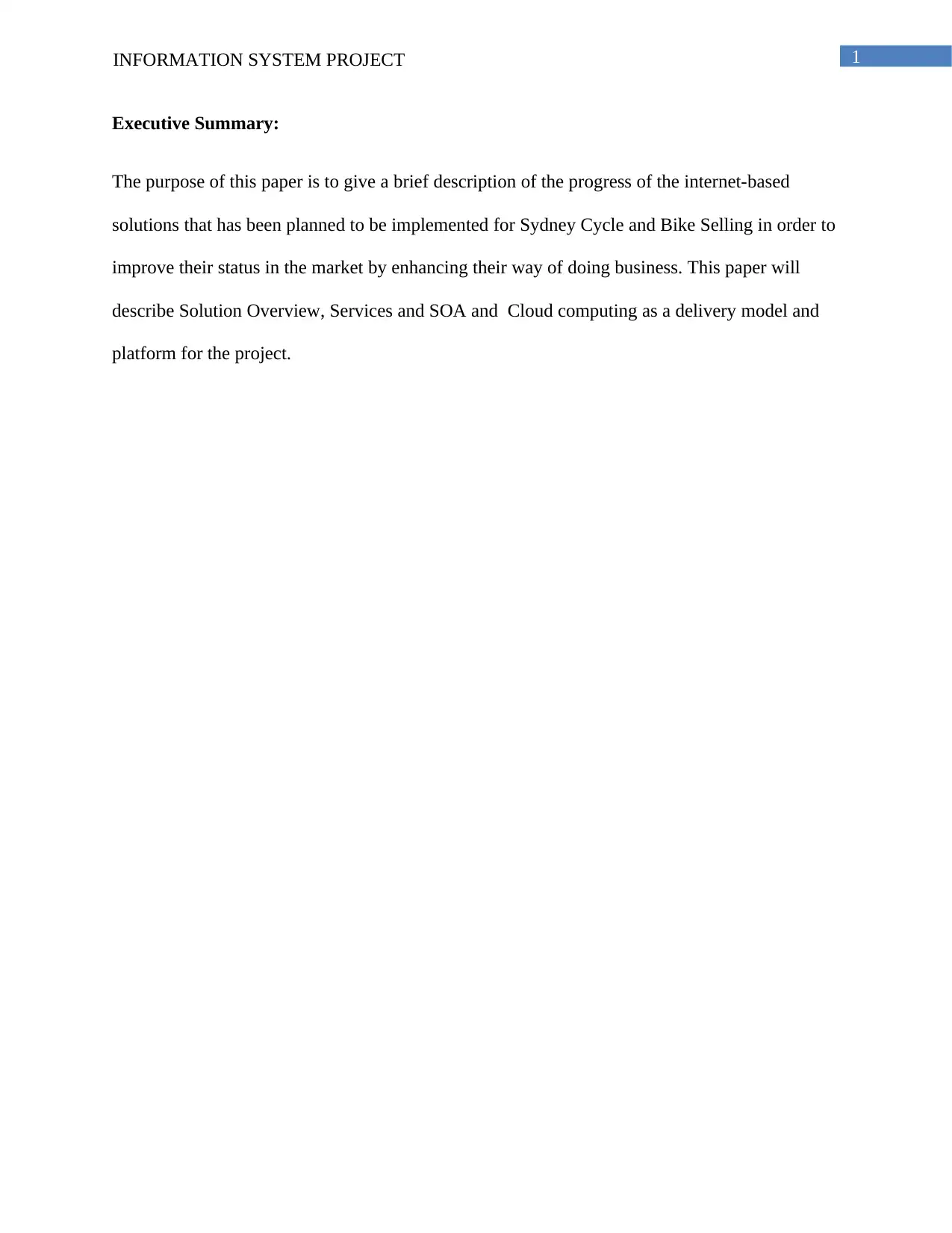
1INFORMATION SYSTEM PROJECT
Executive Summary:
The purpose of this paper is to give a brief description of the progress of the internet-based
solutions that has been planned to be implemented for Sydney Cycle and Bike Selling in order to
improve their status in the market by enhancing their way of doing business. This paper will
describe Solution Overview, Services and SOA and Cloud computing as a delivery model and
platform for the project.
Executive Summary:
The purpose of this paper is to give a brief description of the progress of the internet-based
solutions that has been planned to be implemented for Sydney Cycle and Bike Selling in order to
improve their status in the market by enhancing their way of doing business. This paper will
describe Solution Overview, Services and SOA and Cloud computing as a delivery model and
platform for the project.
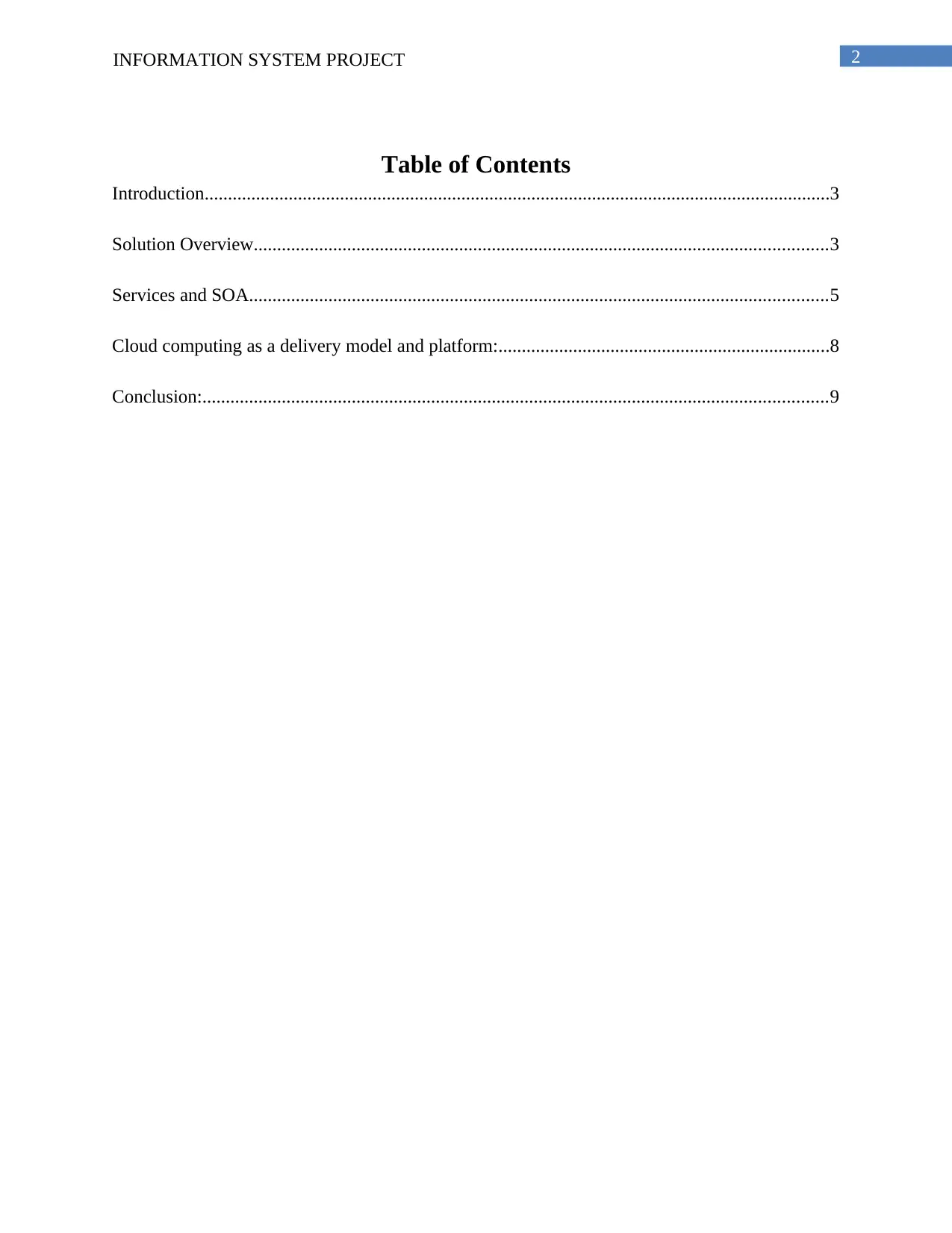
2INFORMATION SYSTEM PROJECT
Table of Contents
Introduction......................................................................................................................................3
Solution Overview...........................................................................................................................3
Services and SOA............................................................................................................................5
Cloud computing as a delivery model and platform:.......................................................................8
Conclusion:......................................................................................................................................9
Table of Contents
Introduction......................................................................................................................................3
Solution Overview...........................................................................................................................3
Services and SOA............................................................................................................................5
Cloud computing as a delivery model and platform:.......................................................................8
Conclusion:......................................................................................................................................9
⊘ This is a preview!⊘
Do you want full access?
Subscribe today to unlock all pages.

Trusted by 1+ million students worldwide
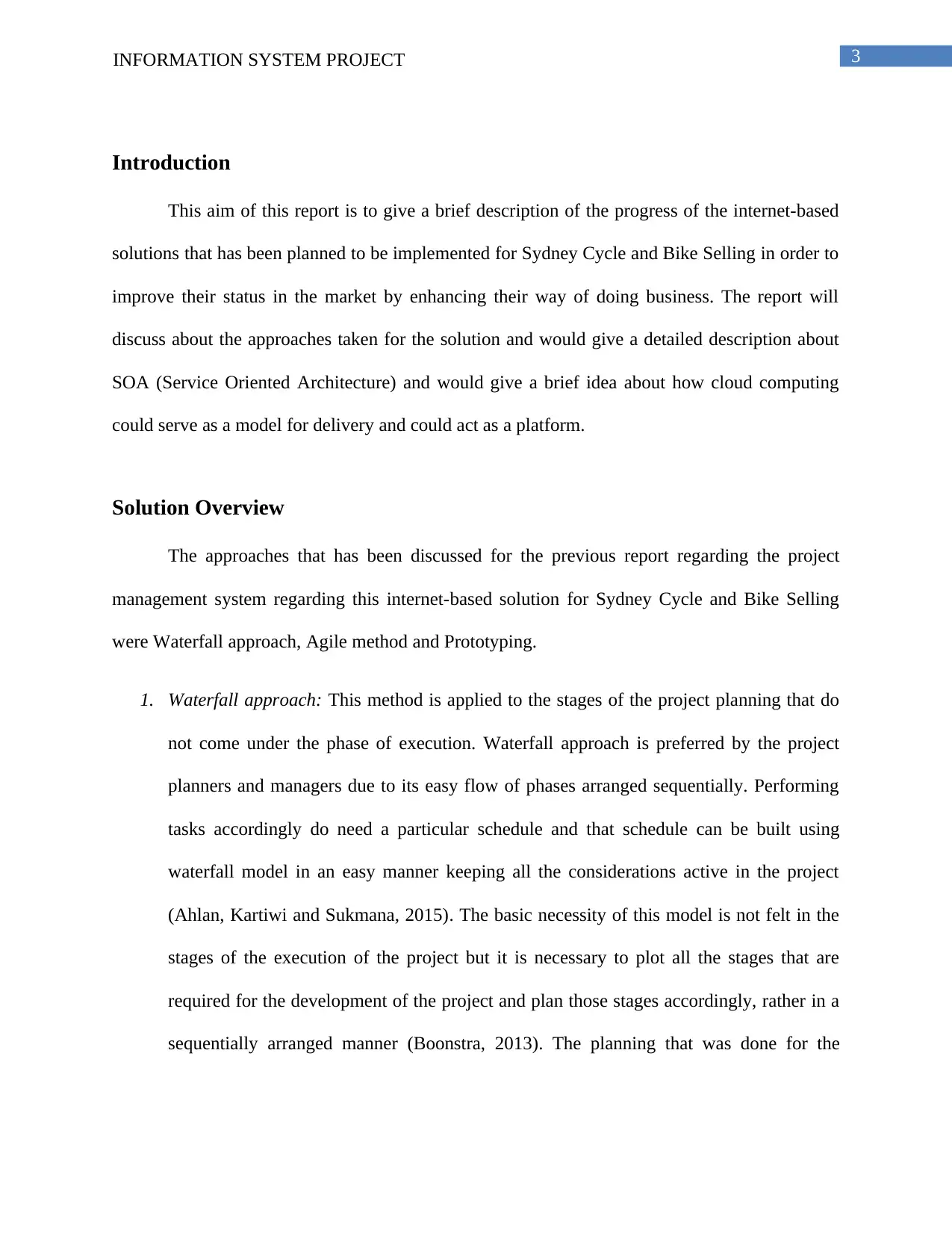
3INFORMATION SYSTEM PROJECT
Introduction
This aim of this report is to give a brief description of the progress of the internet-based
solutions that has been planned to be implemented for Sydney Cycle and Bike Selling in order to
improve their status in the market by enhancing their way of doing business. The report will
discuss about the approaches taken for the solution and would give a detailed description about
SOA (Service Oriented Architecture) and would give a brief idea about how cloud computing
could serve as a model for delivery and could act as a platform.
Solution Overview
The approaches that has been discussed for the previous report regarding the project
management system regarding this internet-based solution for Sydney Cycle and Bike Selling
were Waterfall approach, Agile method and Prototyping.
1. Waterfall approach: This method is applied to the stages of the project planning that do
not come under the phase of execution. Waterfall approach is preferred by the project
planners and managers due to its easy flow of phases arranged sequentially. Performing
tasks accordingly do need a particular schedule and that schedule can be built using
waterfall model in an easy manner keeping all the considerations active in the project
(Ahlan, Kartiwi and Sukmana, 2015). The basic necessity of this model is not felt in the
stages of the execution of the project but it is necessary to plot all the stages that are
required for the development of the project and plan those stages accordingly, rather in a
sequentially arranged manner (Boonstra, 2013). The planning that was done for the
Introduction
This aim of this report is to give a brief description of the progress of the internet-based
solutions that has been planned to be implemented for Sydney Cycle and Bike Selling in order to
improve their status in the market by enhancing their way of doing business. The report will
discuss about the approaches taken for the solution and would give a detailed description about
SOA (Service Oriented Architecture) and would give a brief idea about how cloud computing
could serve as a model for delivery and could act as a platform.
Solution Overview
The approaches that has been discussed for the previous report regarding the project
management system regarding this internet-based solution for Sydney Cycle and Bike Selling
were Waterfall approach, Agile method and Prototyping.
1. Waterfall approach: This method is applied to the stages of the project planning that do
not come under the phase of execution. Waterfall approach is preferred by the project
planners and managers due to its easy flow of phases arranged sequentially. Performing
tasks accordingly do need a particular schedule and that schedule can be built using
waterfall model in an easy manner keeping all the considerations active in the project
(Ahlan, Kartiwi and Sukmana, 2015). The basic necessity of this model is not felt in the
stages of the execution of the project but it is necessary to plot all the stages that are
required for the development of the project and plan those stages accordingly, rather in a
sequentially arranged manner (Boonstra, 2013). The planning that was done for the
Paraphrase This Document
Need a fresh take? Get an instant paraphrase of this document with our AI Paraphraser
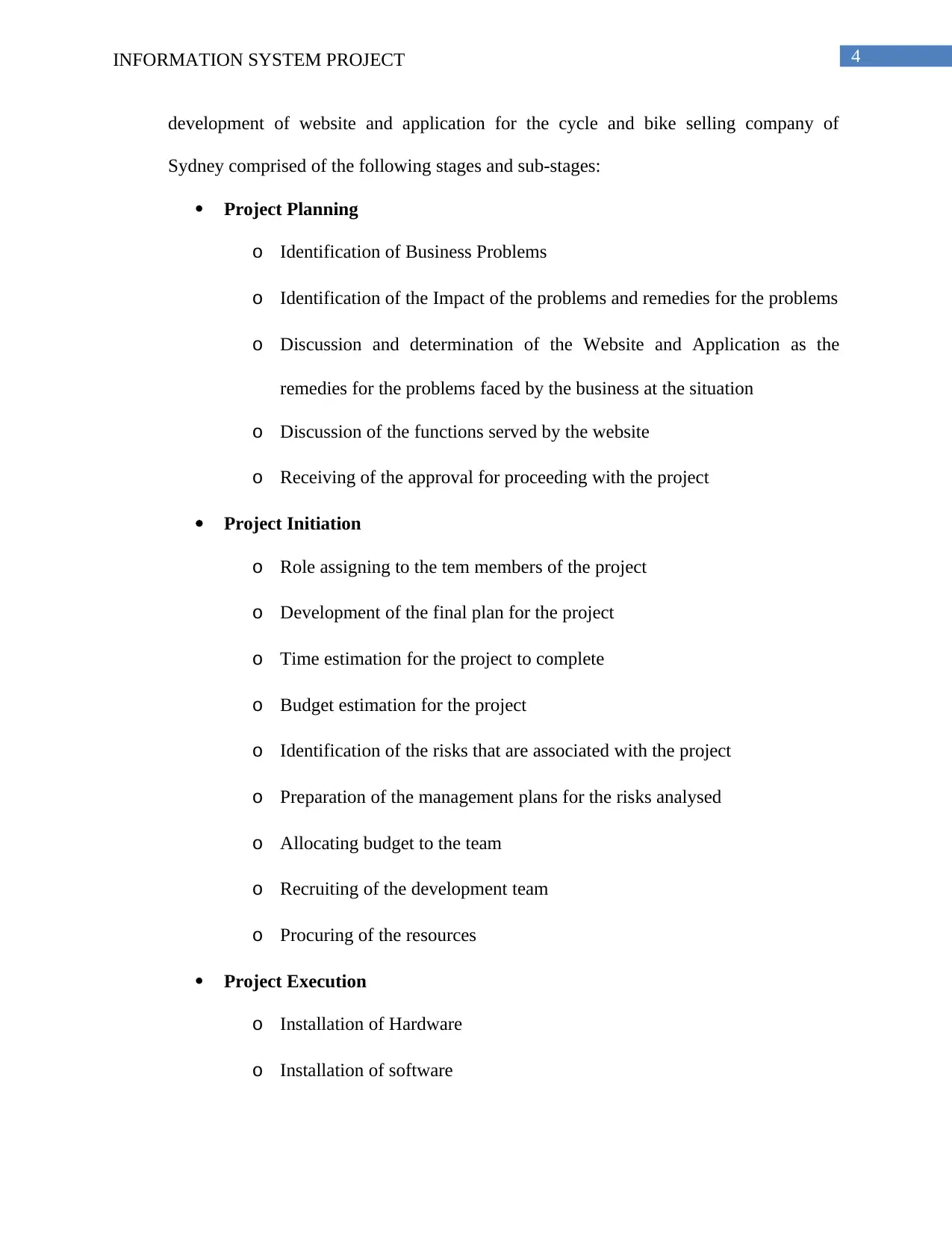
4INFORMATION SYSTEM PROJECT
development of website and application for the cycle and bike selling company of
Sydney comprised of the following stages and sub-stages:
Project Planning
o Identification of Business Problems
o Identification of the Impact of the problems and remedies for the problems
o Discussion and determination of the Website and Application as the
remedies for the problems faced by the business at the situation
o Discussion of the functions served by the website
o Receiving of the approval for proceeding with the project
Project Initiation
o Role assigning to the tem members of the project
o Development of the final plan for the project
o Time estimation for the project to complete
o Budget estimation for the project
o Identification of the risks that are associated with the project
o Preparation of the management plans for the risks analysed
o Allocating budget to the team
o Recruiting of the development team
o Procuring of the resources
Project Execution
o Installation of Hardware
o Installation of software
development of website and application for the cycle and bike selling company of
Sydney comprised of the following stages and sub-stages:
Project Planning
o Identification of Business Problems
o Identification of the Impact of the problems and remedies for the problems
o Discussion and determination of the Website and Application as the
remedies for the problems faced by the business at the situation
o Discussion of the functions served by the website
o Receiving of the approval for proceeding with the project
Project Initiation
o Role assigning to the tem members of the project
o Development of the final plan for the project
o Time estimation for the project to complete
o Budget estimation for the project
o Identification of the risks that are associated with the project
o Preparation of the management plans for the risks analysed
o Allocating budget to the team
o Recruiting of the development team
o Procuring of the resources
Project Execution
o Installation of Hardware
o Installation of software
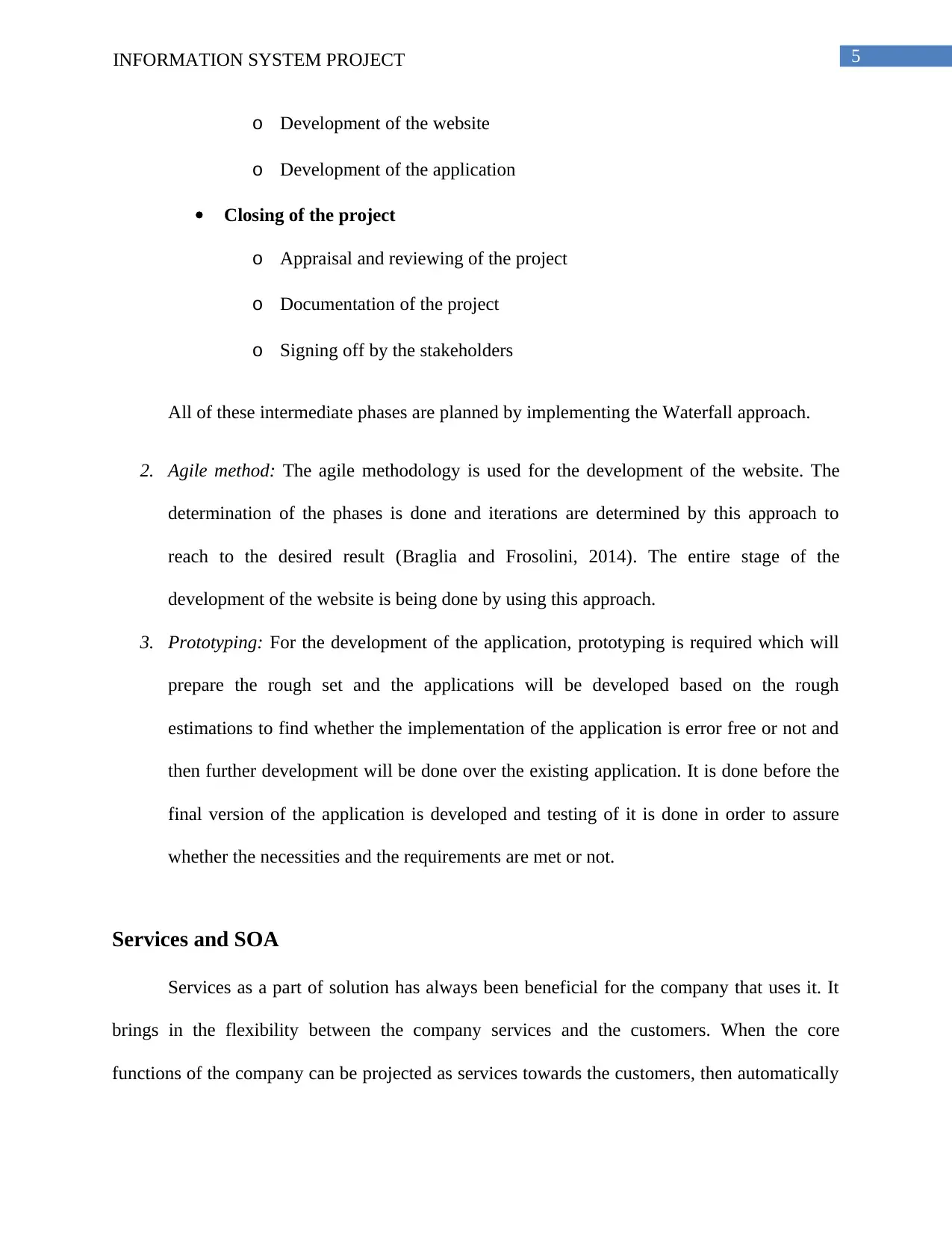
5INFORMATION SYSTEM PROJECT
o Development of the website
o Development of the application
Closing of the project
o Appraisal and reviewing of the project
o Documentation of the project
o Signing off by the stakeholders
All of these intermediate phases are planned by implementing the Waterfall approach.
2. Agile method: The agile methodology is used for the development of the website. The
determination of the phases is done and iterations are determined by this approach to
reach to the desired result (Braglia and Frosolini, 2014). The entire stage of the
development of the website is being done by using this approach.
3. Prototyping: For the development of the application, prototyping is required which will
prepare the rough set and the applications will be developed based on the rough
estimations to find whether the implementation of the application is error free or not and
then further development will be done over the existing application. It is done before the
final version of the application is developed and testing of it is done in order to assure
whether the necessities and the requirements are met or not.
Services and SOA
Services as a part of solution has always been beneficial for the company that uses it. It
brings in the flexibility between the company services and the customers. When the core
functions of the company can be projected as services towards the customers, then automatically
o Development of the website
o Development of the application
Closing of the project
o Appraisal and reviewing of the project
o Documentation of the project
o Signing off by the stakeholders
All of these intermediate phases are planned by implementing the Waterfall approach.
2. Agile method: The agile methodology is used for the development of the website. The
determination of the phases is done and iterations are determined by this approach to
reach to the desired result (Braglia and Frosolini, 2014). The entire stage of the
development of the website is being done by using this approach.
3. Prototyping: For the development of the application, prototyping is required which will
prepare the rough set and the applications will be developed based on the rough
estimations to find whether the implementation of the application is error free or not and
then further development will be done over the existing application. It is done before the
final version of the application is developed and testing of it is done in order to assure
whether the necessities and the requirements are met or not.
Services and SOA
Services as a part of solution has always been beneficial for the company that uses it. It
brings in the flexibility between the company services and the customers. When the core
functions of the company can be projected as services towards the customers, then automatically
⊘ This is a preview!⊘
Do you want full access?
Subscribe today to unlock all pages.

Trusted by 1+ million students worldwide
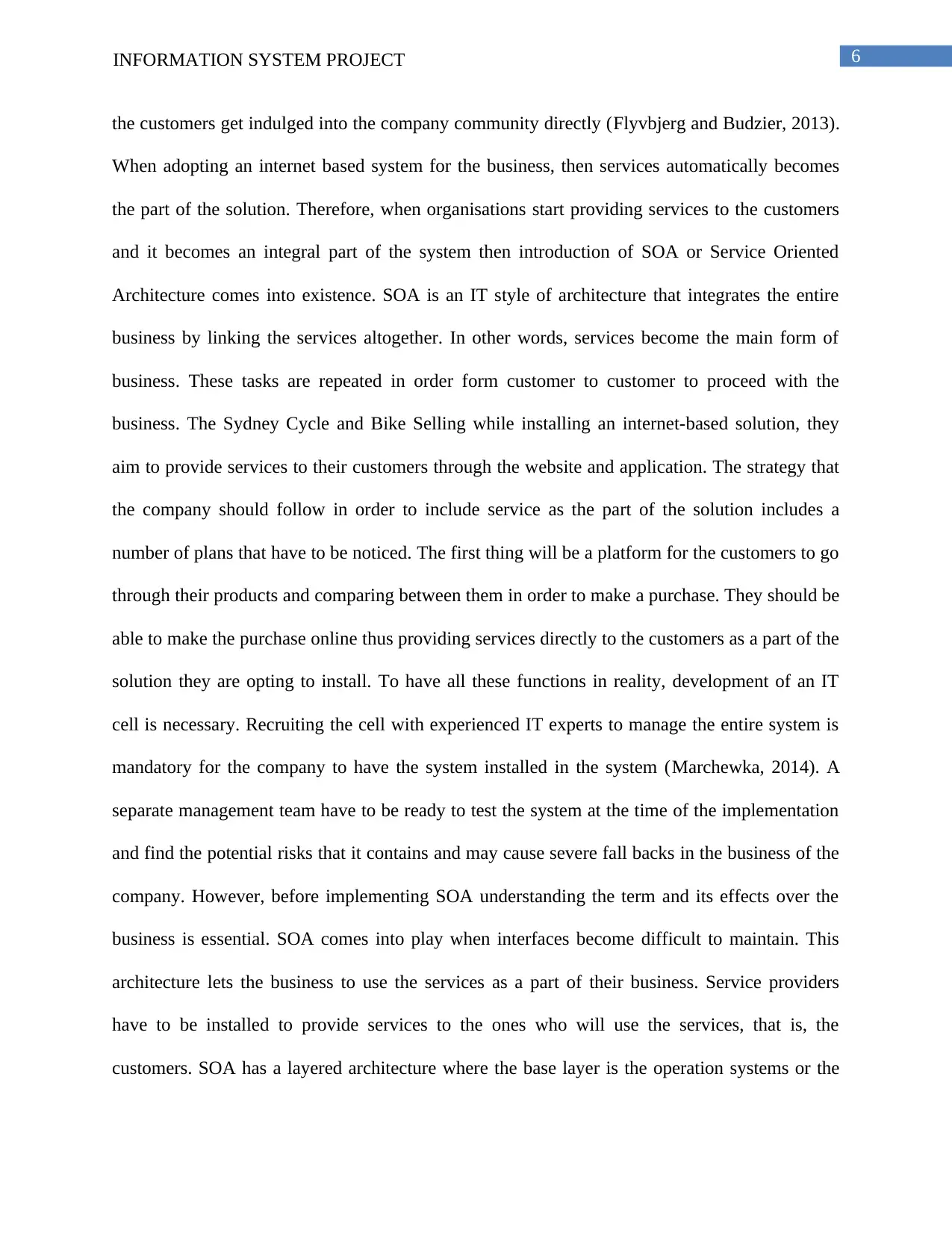
6INFORMATION SYSTEM PROJECT
the customers get indulged into the company community directly (Flyvbjerg and Budzier, 2013).
When adopting an internet based system for the business, then services automatically becomes
the part of the solution. Therefore, when organisations start providing services to the customers
and it becomes an integral part of the system then introduction of SOA or Service Oriented
Architecture comes into existence. SOA is an IT style of architecture that integrates the entire
business by linking the services altogether. In other words, services become the main form of
business. These tasks are repeated in order form customer to customer to proceed with the
business. The Sydney Cycle and Bike Selling while installing an internet-based solution, they
aim to provide services to their customers through the website and application. The strategy that
the company should follow in order to include service as the part of the solution includes a
number of plans that have to be noticed. The first thing will be a platform for the customers to go
through their products and comparing between them in order to make a purchase. They should be
able to make the purchase online thus providing services directly to the customers as a part of the
solution they are opting to install. To have all these functions in reality, development of an IT
cell is necessary. Recruiting the cell with experienced IT experts to manage the entire system is
mandatory for the company to have the system installed in the system (Marchewka, 2014). A
separate management team have to be ready to test the system at the time of the implementation
and find the potential risks that it contains and may cause severe fall backs in the business of the
company. However, before implementing SOA understanding the term and its effects over the
business is essential. SOA comes into play when interfaces become difficult to maintain. This
architecture lets the business to use the services as a part of their business. Service providers
have to be installed to provide services to the ones who will use the services, that is, the
customers. SOA has a layered architecture where the base layer is the operation systems or the
the customers get indulged into the company community directly (Flyvbjerg and Budzier, 2013).
When adopting an internet based system for the business, then services automatically becomes
the part of the solution. Therefore, when organisations start providing services to the customers
and it becomes an integral part of the system then introduction of SOA or Service Oriented
Architecture comes into existence. SOA is an IT style of architecture that integrates the entire
business by linking the services altogether. In other words, services become the main form of
business. These tasks are repeated in order form customer to customer to proceed with the
business. The Sydney Cycle and Bike Selling while installing an internet-based solution, they
aim to provide services to their customers through the website and application. The strategy that
the company should follow in order to include service as the part of the solution includes a
number of plans that have to be noticed. The first thing will be a platform for the customers to go
through their products and comparing between them in order to make a purchase. They should be
able to make the purchase online thus providing services directly to the customers as a part of the
solution they are opting to install. To have all these functions in reality, development of an IT
cell is necessary. Recruiting the cell with experienced IT experts to manage the entire system is
mandatory for the company to have the system installed in the system (Marchewka, 2014). A
separate management team have to be ready to test the system at the time of the implementation
and find the potential risks that it contains and may cause severe fall backs in the business of the
company. However, before implementing SOA understanding the term and its effects over the
business is essential. SOA comes into play when interfaces become difficult to maintain. This
architecture lets the business to use the services as a part of their business. Service providers
have to be installed to provide services to the ones who will use the services, that is, the
customers. SOA has a layered architecture where the base layer is the operation systems or the
Paraphrase This Document
Need a fresh take? Get an instant paraphrase of this document with our AI Paraphraser
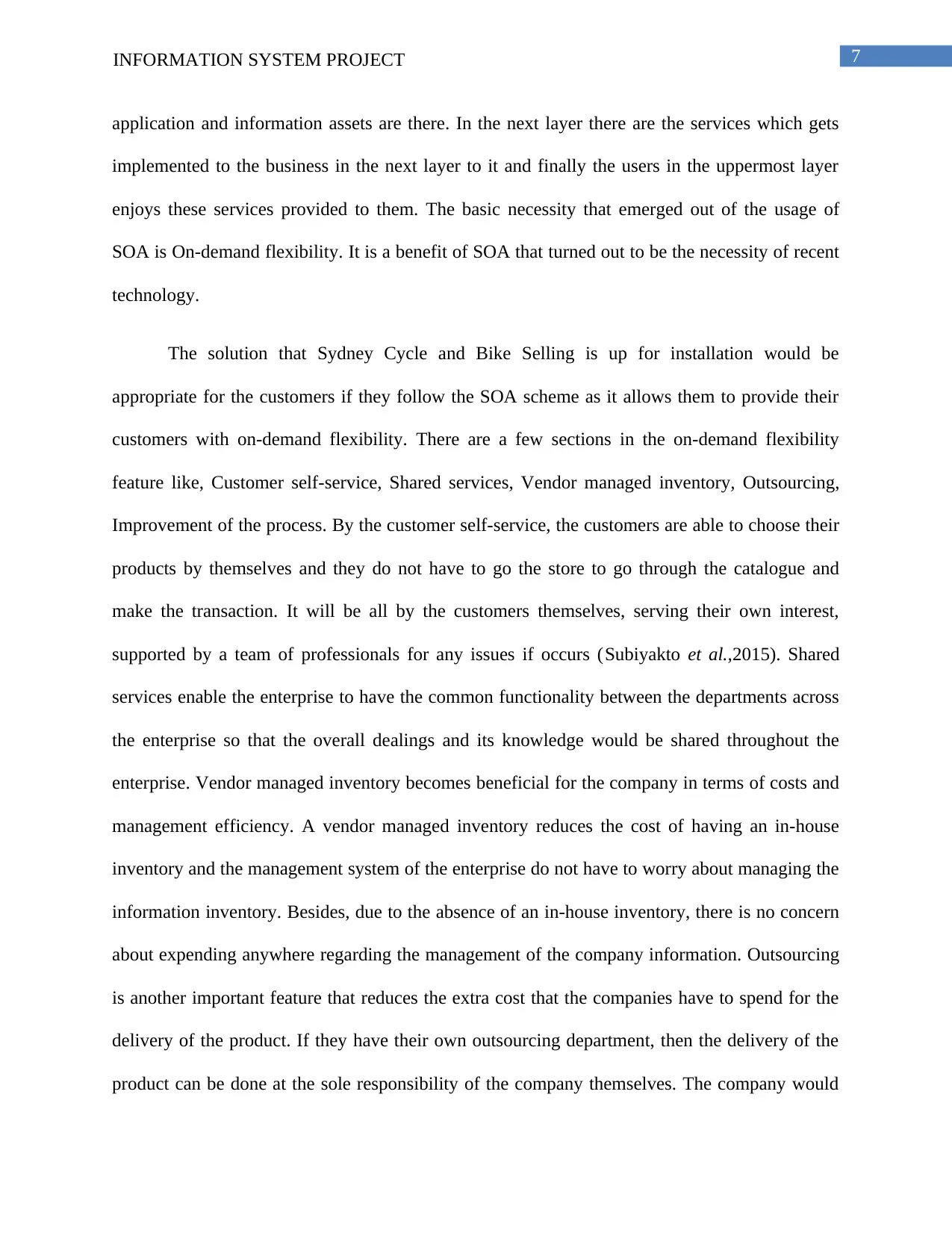
7INFORMATION SYSTEM PROJECT
application and information assets are there. In the next layer there are the services which gets
implemented to the business in the next layer to it and finally the users in the uppermost layer
enjoys these services provided to them. The basic necessity that emerged out of the usage of
SOA is On-demand flexibility. It is a benefit of SOA that turned out to be the necessity of recent
technology.
The solution that Sydney Cycle and Bike Selling is up for installation would be
appropriate for the customers if they follow the SOA scheme as it allows them to provide their
customers with on-demand flexibility. There are a few sections in the on-demand flexibility
feature like, Customer self-service, Shared services, Vendor managed inventory, Outsourcing,
Improvement of the process. By the customer self-service, the customers are able to choose their
products by themselves and they do not have to go the store to go through the catalogue and
make the transaction. It will be all by the customers themselves, serving their own interest,
supported by a team of professionals for any issues if occurs (Subiyakto et al.,2015). Shared
services enable the enterprise to have the common functionality between the departments across
the enterprise so that the overall dealings and its knowledge would be shared throughout the
enterprise. Vendor managed inventory becomes beneficial for the company in terms of costs and
management efficiency. A vendor managed inventory reduces the cost of having an in-house
inventory and the management system of the enterprise do not have to worry about managing the
information inventory. Besides, due to the absence of an in-house inventory, there is no concern
about expending anywhere regarding the management of the company information. Outsourcing
is another important feature that reduces the extra cost that the companies have to spend for the
delivery of the product. If they have their own outsourcing department, then the delivery of the
product can be done at the sole responsibility of the company themselves. The company would
application and information assets are there. In the next layer there are the services which gets
implemented to the business in the next layer to it and finally the users in the uppermost layer
enjoys these services provided to them. The basic necessity that emerged out of the usage of
SOA is On-demand flexibility. It is a benefit of SOA that turned out to be the necessity of recent
technology.
The solution that Sydney Cycle and Bike Selling is up for installation would be
appropriate for the customers if they follow the SOA scheme as it allows them to provide their
customers with on-demand flexibility. There are a few sections in the on-demand flexibility
feature like, Customer self-service, Shared services, Vendor managed inventory, Outsourcing,
Improvement of the process. By the customer self-service, the customers are able to choose their
products by themselves and they do not have to go the store to go through the catalogue and
make the transaction. It will be all by the customers themselves, serving their own interest,
supported by a team of professionals for any issues if occurs (Subiyakto et al.,2015). Shared
services enable the enterprise to have the common functionality between the departments across
the enterprise so that the overall dealings and its knowledge would be shared throughout the
enterprise. Vendor managed inventory becomes beneficial for the company in terms of costs and
management efficiency. A vendor managed inventory reduces the cost of having an in-house
inventory and the management system of the enterprise do not have to worry about managing the
information inventory. Besides, due to the absence of an in-house inventory, there is no concern
about expending anywhere regarding the management of the company information. Outsourcing
is another important feature that reduces the extra cost that the companies have to spend for the
delivery of the product. If they have their own outsourcing department, then the delivery of the
product can be done at the sole responsibility of the company themselves. The company would
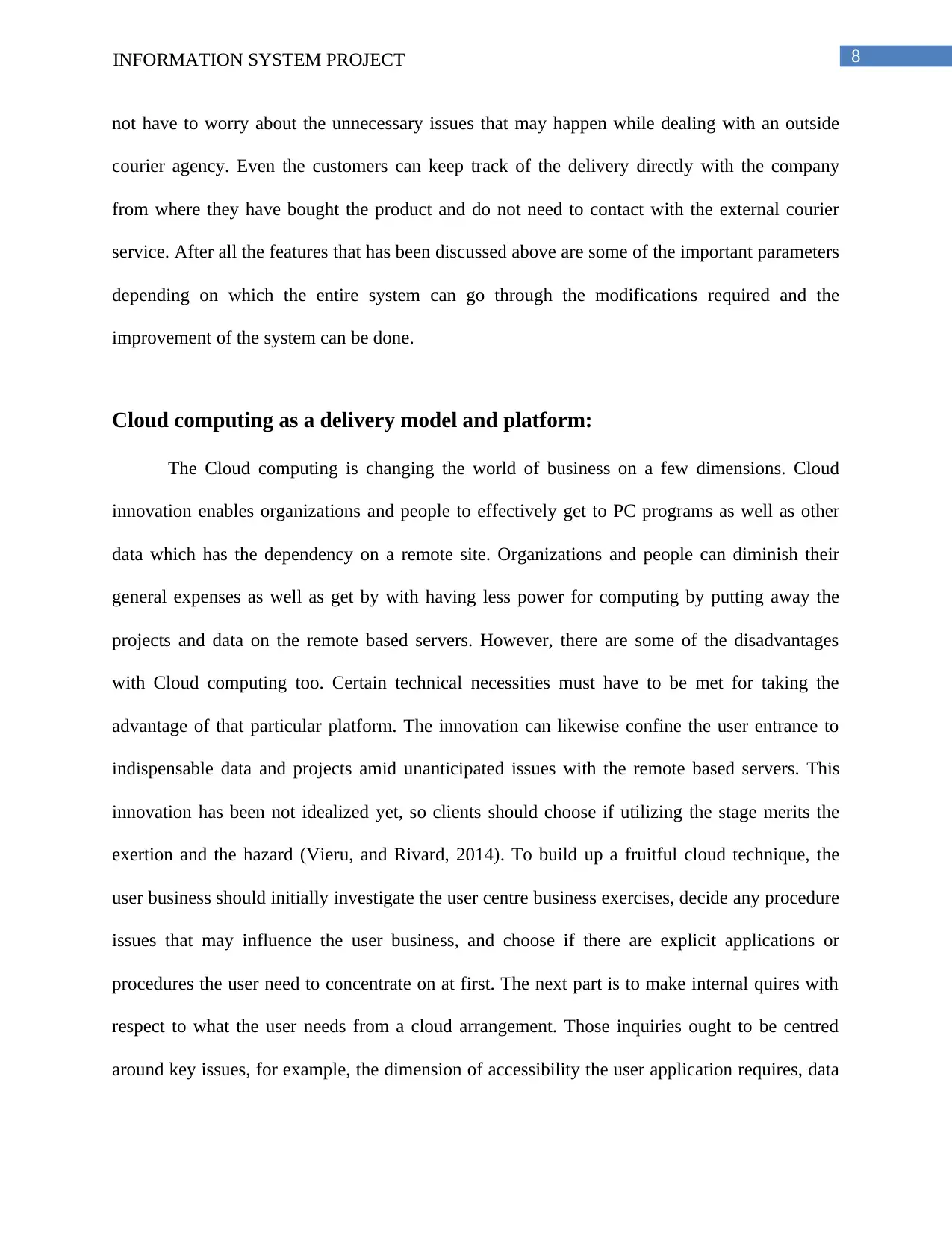
8INFORMATION SYSTEM PROJECT
not have to worry about the unnecessary issues that may happen while dealing with an outside
courier agency. Even the customers can keep track of the delivery directly with the company
from where they have bought the product and do not need to contact with the external courier
service. After all the features that has been discussed above are some of the important parameters
depending on which the entire system can go through the modifications required and the
improvement of the system can be done.
Cloud computing as a delivery model and platform:
The Cloud computing is changing the world of business on a few dimensions. Cloud
innovation enables organizations and people to effectively get to PC programs as well as other
data which has the dependency on a remote site. Organizations and people can diminish their
general expenses as well as get by with having less power for computing by putting away the
projects and data on the remote based servers. However, there are some of the disadvantages
with Cloud computing too. Certain technical necessities must have to be met for taking the
advantage of that particular platform. The innovation can likewise confine the user entrance to
indispensable data and projects amid unanticipated issues with the remote based servers. This
innovation has been not idealized yet, so clients should choose if utilizing the stage merits the
exertion and the hazard (Vieru, and Rivard, 2014). To build up a fruitful cloud technique, the
user business should initially investigate the user centre business exercises, decide any procedure
issues that may influence the user business, and choose if there are explicit applications or
procedures the user need to concentrate on at first. The next part is to make internal quires with
respect to what the user needs from a cloud arrangement. Those inquiries ought to be centred
around key issues, for example, the dimension of accessibility the user application requires, data
not have to worry about the unnecessary issues that may happen while dealing with an outside
courier agency. Even the customers can keep track of the delivery directly with the company
from where they have bought the product and do not need to contact with the external courier
service. After all the features that has been discussed above are some of the important parameters
depending on which the entire system can go through the modifications required and the
improvement of the system can be done.
Cloud computing as a delivery model and platform:
The Cloud computing is changing the world of business on a few dimensions. Cloud
innovation enables organizations and people to effectively get to PC programs as well as other
data which has the dependency on a remote site. Organizations and people can diminish their
general expenses as well as get by with having less power for computing by putting away the
projects and data on the remote based servers. However, there are some of the disadvantages
with Cloud computing too. Certain technical necessities must have to be met for taking the
advantage of that particular platform. The innovation can likewise confine the user entrance to
indispensable data and projects amid unanticipated issues with the remote based servers. This
innovation has been not idealized yet, so clients should choose if utilizing the stage merits the
exertion and the hazard (Vieru, and Rivard, 2014). To build up a fruitful cloud technique, the
user business should initially investigate the user centre business exercises, decide any procedure
issues that may influence the user business, and choose if there are explicit applications or
procedures the user need to concentrate on at first. The next part is to make internal quires with
respect to what the user needs from a cloud arrangement. Those inquiries ought to be centred
around key issues, for example, the dimension of accessibility the user application requires, data
⊘ This is a preview!⊘
Do you want full access?
Subscribe today to unlock all pages.

Trusted by 1+ million students worldwide
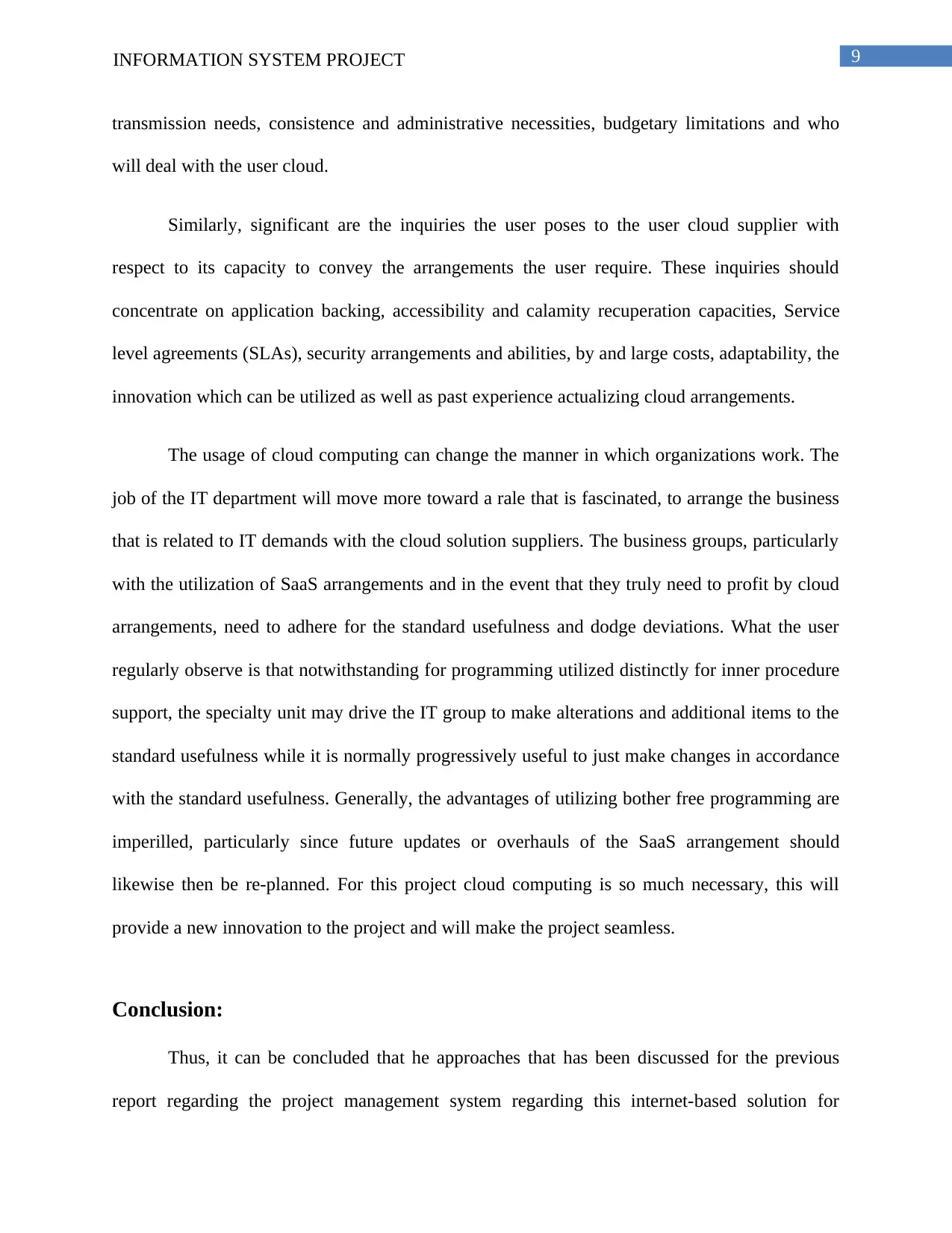
9INFORMATION SYSTEM PROJECT
transmission needs, consistence and administrative necessities, budgetary limitations and who
will deal with the user cloud.
Similarly, significant are the inquiries the user poses to the user cloud supplier with
respect to its capacity to convey the arrangements the user require. These inquiries should
concentrate on application backing, accessibility and calamity recuperation capacities, Service
level agreements (SLAs), security arrangements and abilities, by and large costs, adaptability, the
innovation which can be utilized as well as past experience actualizing cloud arrangements.
The usage of cloud computing can change the manner in which organizations work. The
job of the IT department will move more toward a rale that is fascinated, to arrange the business
that is related to IT demands with the cloud solution suppliers. The business groups, particularly
with the utilization of SaaS arrangements and in the event that they truly need to profit by cloud
arrangements, need to adhere for the standard usefulness and dodge deviations. What the user
regularly observe is that notwithstanding for programming utilized distinctly for inner procedure
support, the specialty unit may drive the IT group to make alterations and additional items to the
standard usefulness while it is normally progressively useful to just make changes in accordance
with the standard usefulness. Generally, the advantages of utilizing bother free programming are
imperilled, particularly since future updates or overhauls of the SaaS arrangement should
likewise then be re-planned. For this project cloud computing is so much necessary, this will
provide a new innovation to the project and will make the project seamless.
Conclusion:
Thus, it can be concluded that he approaches that has been discussed for the previous
report regarding the project management system regarding this internet-based solution for
transmission needs, consistence and administrative necessities, budgetary limitations and who
will deal with the user cloud.
Similarly, significant are the inquiries the user poses to the user cloud supplier with
respect to its capacity to convey the arrangements the user require. These inquiries should
concentrate on application backing, accessibility and calamity recuperation capacities, Service
level agreements (SLAs), security arrangements and abilities, by and large costs, adaptability, the
innovation which can be utilized as well as past experience actualizing cloud arrangements.
The usage of cloud computing can change the manner in which organizations work. The
job of the IT department will move more toward a rale that is fascinated, to arrange the business
that is related to IT demands with the cloud solution suppliers. The business groups, particularly
with the utilization of SaaS arrangements and in the event that they truly need to profit by cloud
arrangements, need to adhere for the standard usefulness and dodge deviations. What the user
regularly observe is that notwithstanding for programming utilized distinctly for inner procedure
support, the specialty unit may drive the IT group to make alterations and additional items to the
standard usefulness while it is normally progressively useful to just make changes in accordance
with the standard usefulness. Generally, the advantages of utilizing bother free programming are
imperilled, particularly since future updates or overhauls of the SaaS arrangement should
likewise then be re-planned. For this project cloud computing is so much necessary, this will
provide a new innovation to the project and will make the project seamless.
Conclusion:
Thus, it can be concluded that he approaches that has been discussed for the previous
report regarding the project management system regarding this internet-based solution for
Paraphrase This Document
Need a fresh take? Get an instant paraphrase of this document with our AI Paraphraser
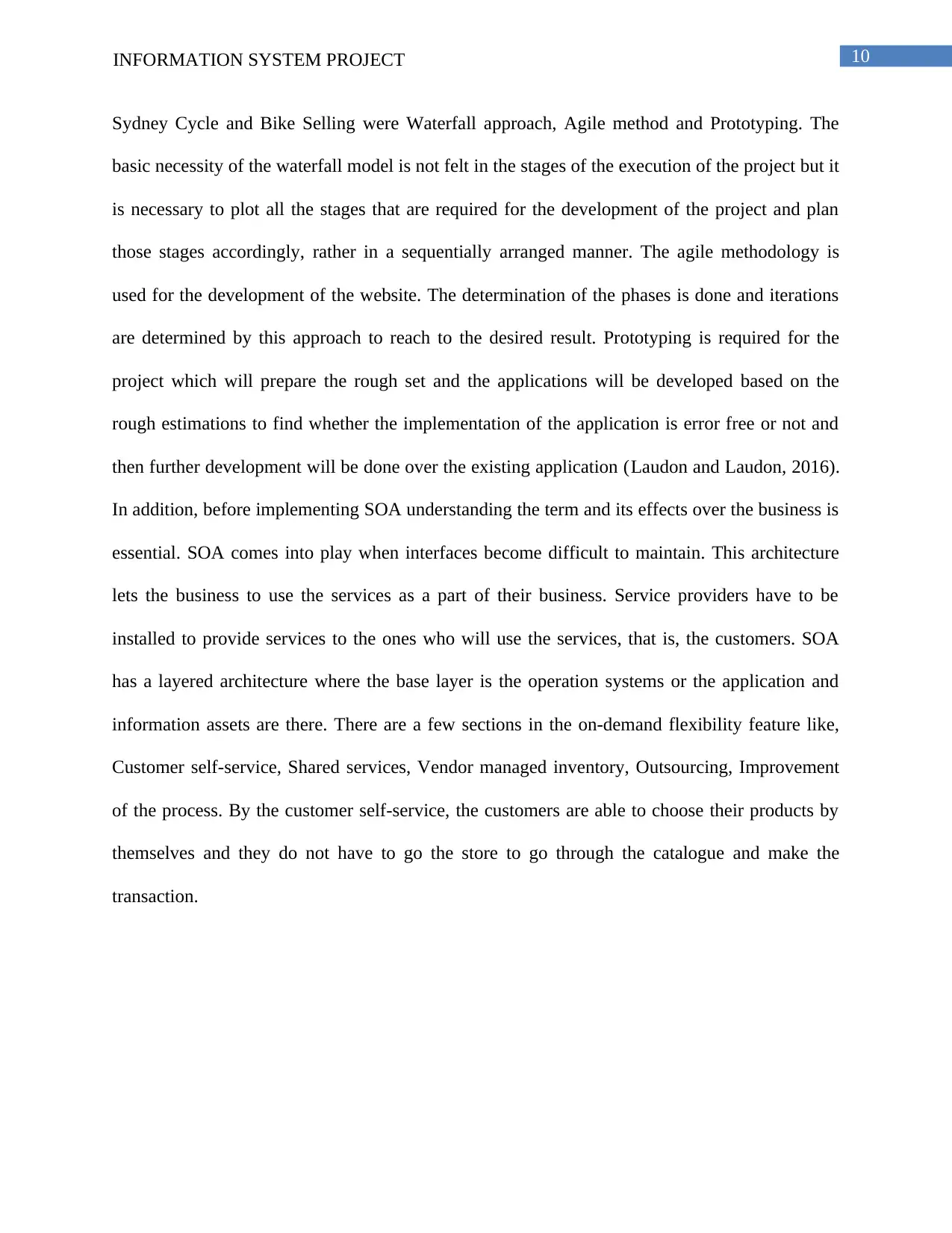
10INFORMATION SYSTEM PROJECT
Sydney Cycle and Bike Selling were Waterfall approach, Agile method and Prototyping. The
basic necessity of the waterfall model is not felt in the stages of the execution of the project but it
is necessary to plot all the stages that are required for the development of the project and plan
those stages accordingly, rather in a sequentially arranged manner. The agile methodology is
used for the development of the website. The determination of the phases is done and iterations
are determined by this approach to reach to the desired result. Prototyping is required for the
project which will prepare the rough set and the applications will be developed based on the
rough estimations to find whether the implementation of the application is error free or not and
then further development will be done over the existing application (Laudon and Laudon, 2016).
In addition, before implementing SOA understanding the term and its effects over the business is
essential. SOA comes into play when interfaces become difficult to maintain. This architecture
lets the business to use the services as a part of their business. Service providers have to be
installed to provide services to the ones who will use the services, that is, the customers. SOA
has a layered architecture where the base layer is the operation systems or the application and
information assets are there. There are a few sections in the on-demand flexibility feature like,
Customer self-service, Shared services, Vendor managed inventory, Outsourcing, Improvement
of the process. By the customer self-service, the customers are able to choose their products by
themselves and they do not have to go the store to go through the catalogue and make the
transaction.
Sydney Cycle and Bike Selling were Waterfall approach, Agile method and Prototyping. The
basic necessity of the waterfall model is not felt in the stages of the execution of the project but it
is necessary to plot all the stages that are required for the development of the project and plan
those stages accordingly, rather in a sequentially arranged manner. The agile methodology is
used for the development of the website. The determination of the phases is done and iterations
are determined by this approach to reach to the desired result. Prototyping is required for the
project which will prepare the rough set and the applications will be developed based on the
rough estimations to find whether the implementation of the application is error free or not and
then further development will be done over the existing application (Laudon and Laudon, 2016).
In addition, before implementing SOA understanding the term and its effects over the business is
essential. SOA comes into play when interfaces become difficult to maintain. This architecture
lets the business to use the services as a part of their business. Service providers have to be
installed to provide services to the ones who will use the services, that is, the customers. SOA
has a layered architecture where the base layer is the operation systems or the application and
information assets are there. There are a few sections in the on-demand flexibility feature like,
Customer self-service, Shared services, Vendor managed inventory, Outsourcing, Improvement
of the process. By the customer self-service, the customers are able to choose their products by
themselves and they do not have to go the store to go through the catalogue and make the
transaction.
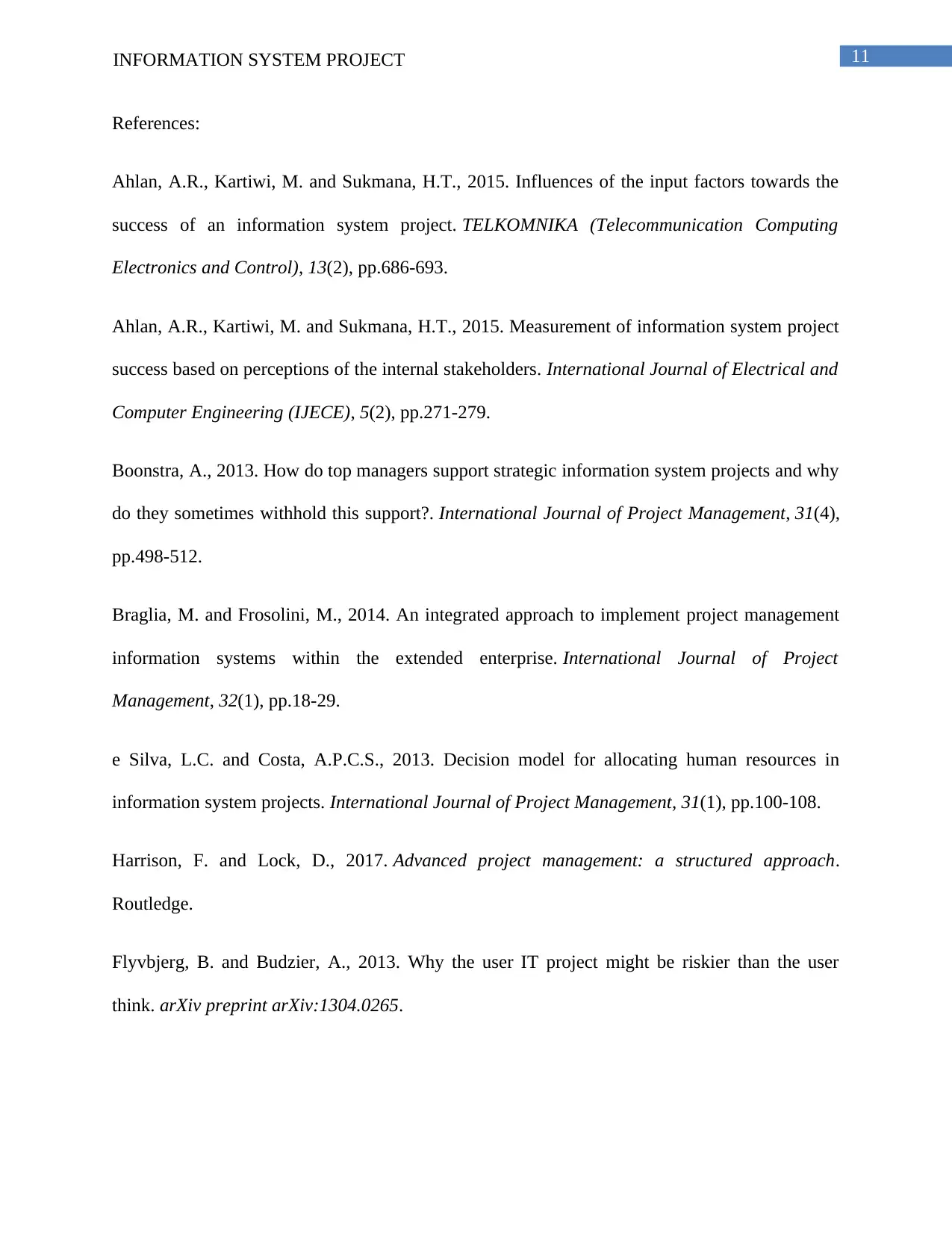
11INFORMATION SYSTEM PROJECT
References:
Ahlan, A.R., Kartiwi, M. and Sukmana, H.T., 2015. Influences of the input factors towards the
success of an information system project. TELKOMNIKA (Telecommunication Computing
Electronics and Control), 13(2), pp.686-693.
Ahlan, A.R., Kartiwi, M. and Sukmana, H.T., 2015. Measurement of information system project
success based on perceptions of the internal stakeholders. International Journal of Electrical and
Computer Engineering (IJECE), 5(2), pp.271-279.
Boonstra, A., 2013. How do top managers support strategic information system projects and why
do they sometimes withhold this support?. International Journal of Project Management, 31(4),
pp.498-512.
Braglia, M. and Frosolini, M., 2014. An integrated approach to implement project management
information systems within the extended enterprise. International Journal of Project
Management, 32(1), pp.18-29.
e Silva, L.C. and Costa, A.P.C.S., 2013. Decision model for allocating human resources in
information system projects. International Journal of Project Management, 31(1), pp.100-108.
Harrison, F. and Lock, D., 2017. Advanced project management: a structured approach.
Routledge.
Flyvbjerg, B. and Budzier, A., 2013. Why the user IT project might be riskier than the user
think. arXiv preprint arXiv:1304.0265.
References:
Ahlan, A.R., Kartiwi, M. and Sukmana, H.T., 2015. Influences of the input factors towards the
success of an information system project. TELKOMNIKA (Telecommunication Computing
Electronics and Control), 13(2), pp.686-693.
Ahlan, A.R., Kartiwi, M. and Sukmana, H.T., 2015. Measurement of information system project
success based on perceptions of the internal stakeholders. International Journal of Electrical and
Computer Engineering (IJECE), 5(2), pp.271-279.
Boonstra, A., 2013. How do top managers support strategic information system projects and why
do they sometimes withhold this support?. International Journal of Project Management, 31(4),
pp.498-512.
Braglia, M. and Frosolini, M., 2014. An integrated approach to implement project management
information systems within the extended enterprise. International Journal of Project
Management, 32(1), pp.18-29.
e Silva, L.C. and Costa, A.P.C.S., 2013. Decision model for allocating human resources in
information system projects. International Journal of Project Management, 31(1), pp.100-108.
Harrison, F. and Lock, D., 2017. Advanced project management: a structured approach.
Routledge.
Flyvbjerg, B. and Budzier, A., 2013. Why the user IT project might be riskier than the user
think. arXiv preprint arXiv:1304.0265.
⊘ This is a preview!⊘
Do you want full access?
Subscribe today to unlock all pages.

Trusted by 1+ million students worldwide
1 out of 13
Related Documents
Your All-in-One AI-Powered Toolkit for Academic Success.
+13062052269
info@desklib.com
Available 24*7 on WhatsApp / Email
![[object Object]](/_next/static/media/star-bottom.7253800d.svg)
Unlock your academic potential
Copyright © 2020–2025 A2Z Services. All Rights Reserved. Developed and managed by ZUCOL.





